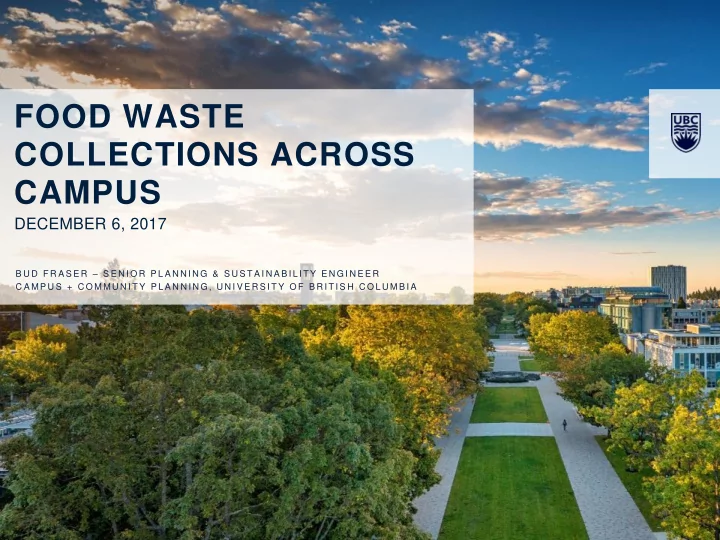

FOOD WASTE COLLECTIONS ACROSS CAMPUS DECEMBER 6, 2017 B U D F R A S E R – S E N I O R P L A N N I N G & S U S T A I N A B I L I T Y E N G I N E E R C A M P U S + C O M M U N I T Y P L A N N I N G , U N I V E R S I T Y O F B R I T I S H C O L U M B I A
UBC CONTEXT Vancouver Campus • 402 hectares (including market housing) • 44,000+ students (FTE) • 13,000+ staff and faculty (FTE) • 20,000 residents • 300+ buildings • 60,000+ daytime population 2
UBC: A COMPOSTING EARLY ADOPTER • Collected food scraps from food services/dining halls back of house, plus voluntary program for academic buildings, and student residences • Finished compost used for landscaping 3
FOOD WASTE COMPOSTING PROGRAM 4
2013: ZERO WASTE ACTION PLAN • Keep food out of garbage: regional government organics disposal ban • Contribute to UBC’s sustainability mission • Economic factors and business case • Campus as a Living Lab: research, teaching and collaboration opportunities • Set a 80% diversion target by 2020, and steadily decrease landfill waste 5
INFRASTRUCTURE FOR BUILDINGS The Past: stand- Now: recycling stations including food alone garbage scraps at consolidated locations cans everywhere 6
KEY ISSUE: FOOD SCRAPS CONTAMINATION 7
PERFORMANCE BY LOCATION & AUDIENCE Food Academic Student Street/ Service/ Buildings/ Residences Outdoor Back of Food House Service FOH Participation & recovery Keeping it clean More challenging 8
CASE STUDY: STUDENT RESIDENCE STUDY Walter Gage Residence 9
RESIDENCE BARRIERS & SOLUTIONS Barriers • Somewhat transient audience, from many different backgrounds and geographic locations: lack of familiarity • Inconvenience: 2-way trips to empty pails in the green bins (sometimes long trips) • Yuck factor • Other priorities (like exams) • Need for carryable bags (i.e., plastic) • Plastic grocery bags contaminating green bins 10
CASE STUDY: RESIDENTIAL CONVENIENCE STUDY Location: Walter Gage Residence (suite-style), 17 storey towers Experimental setup: 2. Chutes open – 3. Hallway dropoff – 1. Chutes closed, basement dropoff – inconvenient; 1 tower convenient; 1 tower inconvenient; w/ varying distances 11
RESIDENTIAL CONVENIENCE STUDY - RESULTS 0.6 0.5 Weight of compost recycling 0.4 (kg/person/week) 0.3 0.2 0.1 0.0 41ft 86ft 97ft 163ft Chutes open Hallway Basement Dropoff - Inconvenient Inconvenient Convenient 12
RESIDENCE BARRIERS & SOLUTIONS Solutions • Increase convenience in design of new buildings – Floor-based stations (best) or ground floor recycling rooms • Improve design and setup of recycling rooms – Well lit, clean, ventilated – Bins & signage consistent with rest of campus – Use colours and painting to provide visual signals – Frequent transfer of food waste to loading bay to minimize odours • Provision of carryable, compostable plastic bin liner bags to residents • Engage residents in multiple ways to address participation and contamination 13
FOOD SCRAPS ON THE STREET 14
WHAT WILL IT TAKE TO REACH FULL RESOURCE RECOVERY? ~100% resource recovery • Human behaviour is key Communications & Engagement, (eg sorting) Incentives • Sorting decisions are complex given diversity of products • A holistic systems Infrastructure & approach is needed, systems including procurement • Simple • Intuitive and business practices • Convenient 15
INFRASTRUCTURE & SIGNAGE Graphic & text signage 16
INFRASTRUCTURE & SIGNAGE “3D” display signage 17
KEY ISSUE: CUPS & SINGLE USE CONTAINERS • Sorting is challenging: wide range of container types & materials; hard to create very simple, intuitive sorting rules • Contributes to food scraps contamination 18
ALIGNMENT OF FOOD PACKAGING • Simplify and align single use food packaging choices with infrastructure & systems • Requires engagement with food service providers & procurement 19
COMMUNICATIONS & ENGAGEMENT 20
SUMMARY OF LESSONS LEARNED Convenient, well designed infrastructure High Align food impact Multi-pronged packaging with communications food waste systems & engagement program System capacity & limitations 21
RESOURCES & LINKS Recycling Infrastructure Guidelines for UBC Buildings Paper: Convenience improves composting and recycling rates in high- density residential buildings Zero Waste Squad UBC’s Compost System video UBC Food Service Ware Guideline Metro Vancouver organics ban 22
Bud Fraser Senior Planning & Sustainability Engineer Sustainability and Engineering | Campus + Community Planning bud.fraser@ubc.ca +1 604 822 1501 sustain.ubc.ca
Recommend
More recommend